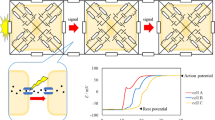Abstract.
A mathematical model of the HCO− 3-secreting pancreatic ductal epithelium was developed using network thermodynamics. With a minimal set of assumptions, the model accurately reproduced the experimentally measured membrane potentials, voltage divider ratio, transepithelial resistance and short-circuit current of nonstimulated ducts that were microperfused and bathed with a CO2/HCO− 3-free, HEPES-buffered solution, and also the intracellular pH of duct cells bathed in a CO2/HCO− 3-buffered solution. The model also accurately simulated: (i) the effect of step changes in basolateral K+ concentration, and the effect of K+ channel blockers on basolateral membrane potential; (ii) the intracellular acidification caused by a Na+-free extracellular solution and the effect of amiloride on this acidification; and (iii) the intracellular alkalinization caused by a Cl−-free extracellular solution and the effect of DIDS on this alkalinization. In addition, the model predicted that the luminal Cl− conductance plays a key role in controlling both the HCO− 3 secretory rate and intracellular pH during HCO− 3 secretion. We believe that the model will be helpful in the analysis of experimental data and improve our understanding of HCO− 3-transporting mechanisms in pancreatic duct cells.
Similar content being viewed by others
Author information
Authors and Affiliations
Additional information
Received: 18 October 1995/Revised: 5 July 1996
Rights and permissions
About this article
Cite this article
Sohma, Y., Gray, M., Imai, Y. et al. A Mathematical Model of the Pancreatic Ductal Epithelium. J. Membrane Biol. 154, 53–67 (1996). https://doi.org/10.1007/s002329900132
Issue Date:
DOI: https://doi.org/10.1007/s002329900132




